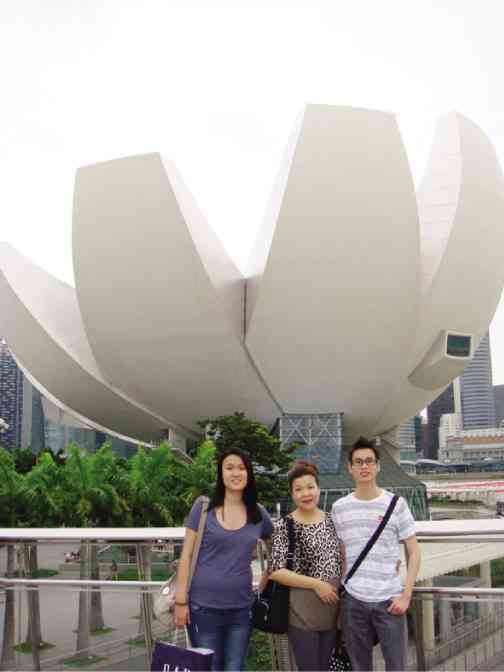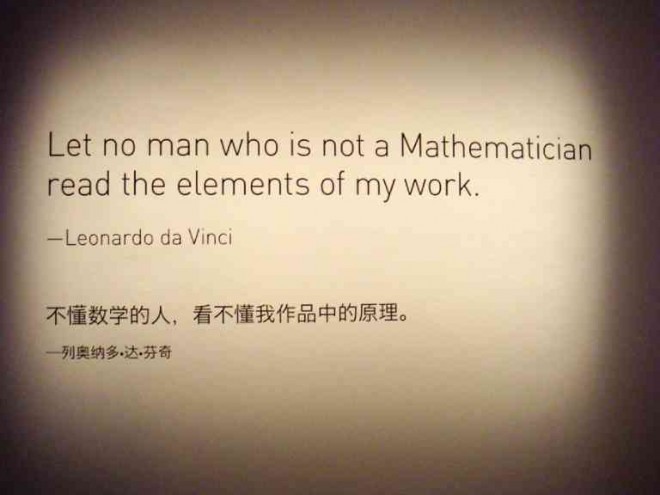Da Vinci and left-handedness
On a recent family Christmas vacation in Singapore, we spent an afternoon at the Art Science Museum in Marina Bay Sands.
Opened in 2011, the museum’s lotus-shaped architecture was, by itself, a sight to behold. What made us visit the museum, instead of the gigantic shopping centers nearby, was “Shaping the Future,” an exhibit of Leonardo da Vinci’s contributions to Mathematics, Natural Science, Architecture, Technology and Music.
Da Vinci is, of course, famous for his paintings of the “Mona Lisa” and the “Lord’s Supper.” In the Singapore exhibit, there was a video of how intricately the painting, also known as the “Last Supper,” was conceived and executed—a showcase of Da Vinci’s talents in art and Math.
Walking down the galleries, one was amazed at the diversity of Da Vinci’s talents. There was the sketch of his “mechanical bird” (the flying machine), his famed sketch of the human anatomy, his precise drawing of water movements, his designs of a church and illustrations of small intricate tools, his mathematical formulations, his sayings, his thoughts, his observations and reflections—on objects, of life, even death—all documented in his private journals of some 6,000 pages, 13 of which are now on display and 13 more by mid-exhibit period, while other pages are making the rounds of museums around the world.
The highlight of the exhibit was Codex Atlanticus, the largest compilation of Da Vinci’s personal notes that contained his original sketches and writings.
Article continues after this advertisementAs I came to the first page of the exhibit of his manuscripts, I was pleasantly surprised to see something strange yet familiar. Apparently, Da Vinci was left-handed and he wrote beautifully and neatly. But every letter and word was written in mirror image—from right to left.
Article continues after this advertisementAnyone who cares to read would do better to read the back of the page rather than the front. But since the pages were placed upright on display inside a glass frame, a mirror was set up behind so the pages could be read.

THE WRITER and her children posing with the distinctive, lotus-shaped architecture of the Art Science Museum in the background.
Mirror-image writing
I smiled as I looked at the pages because that was exactly how my son used to write when he was in kindergarten. I still keep as souvenir his paper with his name Christian written rapidly in mirror image.
As an educational psychologist major then, I knew a thing or two about left-handedness, so I thought I should inform his teacher of this “phenomenon.” I asked the teacher that if the reverse writing should happen, to kindly just turn the paper and read from the back.
Then I added, “Please don’t change his handedness.” Eventually, however, Christian learned to write from left to right of the page. He still writes with his left hand today.
I learned from the captions of Da Vinci’s exhibits that in the early years, when his notebooks were passed from one hand to another, the owners and curators in Italy thought they were written in Chinese. And since no one among them could read Chinese, they were not sure what to do with these pages.
Why did Da Vinci write from right to left of the page? There were many theories, one of which was simply because the ink would smudge if he were to write like we righties do—from left to right of the page.
My son had the same problem but it was a different story. As a student in a Philippine-Chinese school, his curriculum included Chinese calligraphy; but his calligraphy looked queer and he was given barely passing marks. Essentially, it is because the aesthetics of Chinese calligraphy is based on famous works of “righties,” with the force and direction of each stroke going naturally from the left to right.
When the lefties write Chinese characters, the sequence of each stroke is from the wrong direction and the force and slant of the ink is in the wrong place. Moreover, the ink smudges all over if lefties try to write each character in the same direction as righties.
In other words, Chinese calligraphy—at least in class—does not allow for mirror-image writing.
Left-handed students
So how can we help left-handed students? I had many students at the University of the Philippines who were lefties. One semester in my undergraduate class, I had more lefties in class than normal. I remember allowing left-handed students extra 15 minutes to finish their exams. Without arm support on chairs built for righties, they exerted more effort to write well.
On another semester in a master’s class, I noticed a pair of severely left-handed students seated in front taking down notes on papers slanted almost upside down. Knowing from experience that left-handed people could read in reverse, I asked them if they would demonstrate that skill by reading what was on the board. The whole class was amazed by the ease and speed it took them to read.
Left-handed students said it actually took them longer to read books written from left to right than reading the page in reverse.
Spatial orientation
When I noticed Christian was taking interest and beginning to read, but in reverse, I covered with my fingers parts of a word with more than one syllable, so that he would focus on the first syllable, then the second, then the third.
For each sentence, I covered the latter words so he could focus on the first word, then the second, then the third and so on.
It was a tedious process for me but it was necessary to train his visual orientation. Because of his natural right-left orientation, he experienced a temporary period of mild dyslexia and spelling problem. They were corrected eventually but slowly.
But an incident made me discover his spatial intelligence. Christian came home one day, when he was still in kindergarten, with a test paper marked all wrong.
When I asked why, I found out the lesson was about shapes. Christian drew a cube when asked to draw a square. He produced a sphere when asked to draw a circle. As for a triangle, his drawing was a pyramid. He was seeing shapes in three dimensions.
All his drawings of robots and game characters at home were also three-dimensional. So, after a college degree in Environmental Science from Ateneo de Manila University, he fulfilled his dream of going abroad for further studies in video game design.
Many studies have shown that the left-handed are gifted with spatial intelligence and they are more creative when divergent thinking is required as in The Torrance Test of Creativity.
In a postmortem study, it was found that a left-handed’s brain had a bigger corpus callosum, which means the interaction between the two brain hemispheres was more active, hence the higher flexibility in thinking.
The exhibits in the Singapore Art Science Museum run until May.
The writer is an associate professor of educational psychology at the University of the Philippines College of Education. E-mail her at [email protected].

